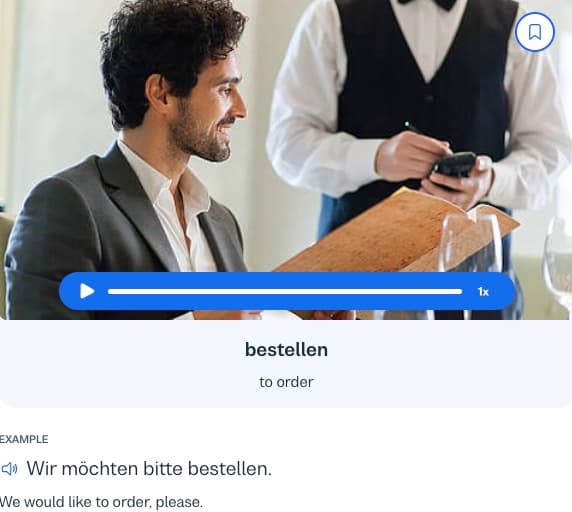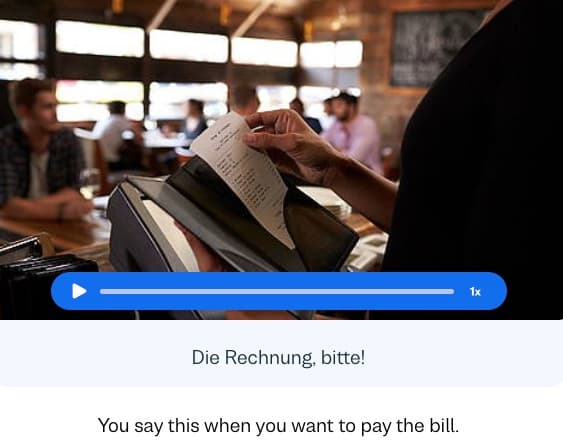I want to learn...
Traveling is exciting but can also be very exhausting. After a long flight you might be starving. So, what would you most likely do when arriving in Germany? Right – order some food in German. (Check out our article on German travel phrases also!)
It is an exciting opportunity to use your German skills right after arriving. But don’t worry, a simple“ Hallo, ich hätte gern ein/eine/einen …“ is already enough to make sure you’ll get what you want after reading the menu in German.
In this article you will learn phrases and words for casually ordering food in German, whether you want to have Schnitzel for dinner at a restaurant, go for a coffee, or drink a nice cold beer at Oktoberfest.
Let’s get started!
How to order food in German
Just a little reminder before you dive into German cuisine and traditional German dishes: Like everywhere else it is important to be polite and friendly. Just start the conversation with a simple “Hallo”, “Guten Tag” or “Guten Abend”.
Since you want something from the other person it is also appropriate to use “Bitte” (please) and “Danke” (Thank you) or “Vielen Dank” (Thank you very much).
Phrases to order
If you are asking yourself, “How can I order in German?”, make sure to keep the following phrases in mind. They are like magic and people will love that you are asking in German.
While the person in the restaurant, bakery or bar will most likely ask “Was darf es sein?”, “Was möchten Sie?” (What would you like?) or just a simple“Bitte?” (Please?), you can use one of these phrases:
Ich hätte gern ein (neutral) / eine (female) / einen (male) …
That’s the classic one and means “I would like to have a/an…”. You can also say: “Ich möchte gern ein/eine/einen …” which has the same meaning. The little word “gern” doesn’t have an equivalent in English but it makes the phrase a bit more polite and friendly. You can find that word in lots of German phrases.
Ich nehme ein/eine/einen… (I’ll have a/an…)
Für mich ein/eine/einen… (For me a…)
You can use this one when you are with other people so that you can indicate that you are the next one ordering.
Now let’s see the various dishes that you can order in a typical German menu in the next section.
German menu
Menus in German-speaking countries are usually divided into the sections “Vorspeisen”, “Hauptgerichte”, “Nachtisch” und “Getränke”. Let’s have a closer look at what they include:
1. Vorspeisen
These are the starters that you will have before your main course. You can find soups, salads, bread with dips, etc. Known as the country with the greatest bread diversity, you can try more than 3000 different types of bread in Germany.
2. Hauptgerichte
In this menu section, you will find all the main dishes including meat, fish, lots of vegetarian options and, of course, popular German dishes.
3. Nachtisch
You can see this in the menu section also called“Nachspeise” or like in other languages “Desserts”. That is the section when you are looking for something sweet. How about a classic German Schwarzwälder Kirschtorte ?
4. Getränke
If you would like to drink something, you are right in this menu section. You can find all drinks divided into alcoholic and non-alcoholic drinks.
Ready to try one of the 5000 different kinds of German beers? Here are two easy phrases on how to order a beer in German:
“Ich hätte gern ein Bier.”
“Ich nehme ein Bier, bitte.”
What would you like to order in German?
In case you have the menu in your hands and still don’t know what to order, here is a list of traditional German dishes you should try for your local experience:
1. Bratwurst
You can find a huge variety of sausages in Germany but the Bratwurst is the all-time classic, as street food, main course at the restaurants with some mashed potatoes and Sauerkraut, or for BBQ’s with family and friends.
2. Currywurst
Berlin’s specialty served as sliced sausage with a spicy curry ketchup.
3. Schnitzel
The world-famous Schnitzel, also known as“Wiener Schnitzel”as it comes originally from Vienna’s cuisine. This thin slice of meat is originally made of veal, breaded and fried.
4. Kartoffelsalat
The classic german potato salad is made either with mayonnaise or a vinegar dressing. You can find Kartoffelsalat as garnish for Schnitzel, Bratwurst, at every BBQ or even at Christmas dinners. Potato salad and sausages is a popular dish For Christmas Eve in Germany.
5. Brezel
This famous snack is best served when it comes fresh out of the oven with some salt and butter. You can order Brezel at almost every bakery and Biergarten. Because this is the place where most people consume Brezel.
6. Sauerkraut
It is a kind of cabbage and served as a side dish in traditional German kitchen.
Placing your order in German
Once you have decided what kind of Vorspeise, Hauptgericht, Nachtisch and Getränk you would like you are finally ready to place your order in German:
Ich hätte gern ein Schnitzel.
Ich hätte gern eine Bratwurst.
Ich nehme ein Bier, bitte.
Für mich eine Cola, bitte.
Ich hätte gern einen Nachtisch.
More phrases on how to ask in German
1. Phrases when mentioning restrictions and allergies
Make sure to mention special needs when you order German dishes in case you have some dietary restrictions or allergies, or if you are vegetarian or vegan. The following phrases could be important for you:
Ich bin allergisch gegen… = I’m allergic to…
You can use this phrase for any kind of allergy, e.g. “Ich bin allergisch gegen Gluten” (I’m allergic to gluten.)
Ich esse keinen Fisch. (I don’t eat fish.)
Ich bin Vegetarierin (female) / Vegetarier (male). (I’m vegetarian.)
Ich bin Veganerin (female) / Veganer (male). (I’m vegan.)
2. How to ask to go to the bathroom in German
If you need to go to the bathroom, you can use the question “Wo ist die Toilette?” which is the translation for “Where is the bathroom”.
A more informal expression would be the abbreviation “WC”. It stands for water closet. You will definitely read it on the doors of restrooms but you can also say it in the question“Wo ist das WC?”.
3. How to ask for the check in German
Now it is time to pay. You hopefully enjoyed your meal and are not starving anymore. Maybe you even had a nice home brewed beer. If you want to leave the place, there are several ways to ask for the check in German.
Here are 4 useful phrases:
Ich würde gerne bezahlen. (I would like to pay.)
Die Rechnung, bitte. (The bill, please.)
Zahlen, bitte. (Check, please.)
Kann ich bezahlen? (Can I pay?)
Say “Danke” after receiving the bill and choose cash or bank card as payment method. Attention! In Germany you should tip around 10%.
Good to know: If you are leaving the restaurant and want to say goodbye in German, you can say: “Auf Wiedersehen!” Check out our article on how to say goodbye in German!
How to order food to go
To order food to go in German, you need the phrase “zum Mitnehmen” in any occasion, no matter if it is a coffee to go, a pizza to go or a delicious kebab for takeaway. If you order food or a coffee, the person at the restaurant, café etc. will probably ask you:
Für hier oder zum Mitnehmen? (For here or for takeaway?) (literally translated)
In this case it is enough to reply“zum Mitnehmen” which means “for takeaway”. However, you could already specify that when you order:
Ich hätte gern einen Kaffee zum Mitnehmen. (I would like a coffee to go.)
That works in any situation and you can just replace“einen Kaffee” with another food or beverage you would like to order.
Ordering food in German: Recap
This is all you need to know about how to order at a restaurant, how to order for takeaway or how to order a drink in German. Now you are ready to embark on your culinary journey in Germany. Take the chance to try some local specialties.
Guten Appetit! (Enjoy your meal!)
Newlanguages


